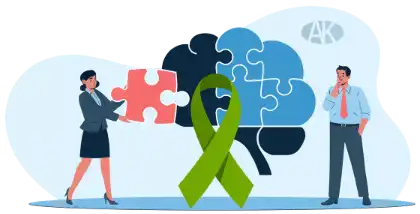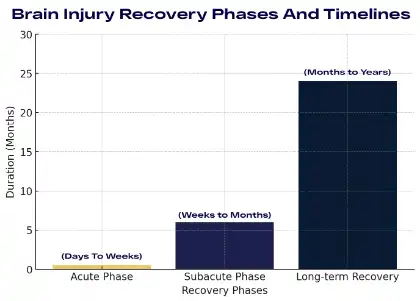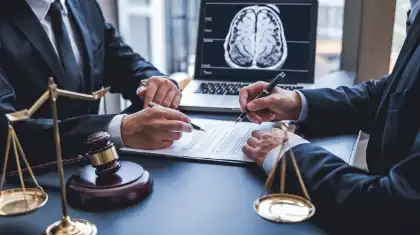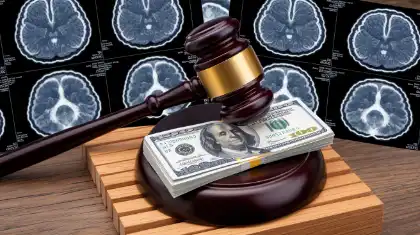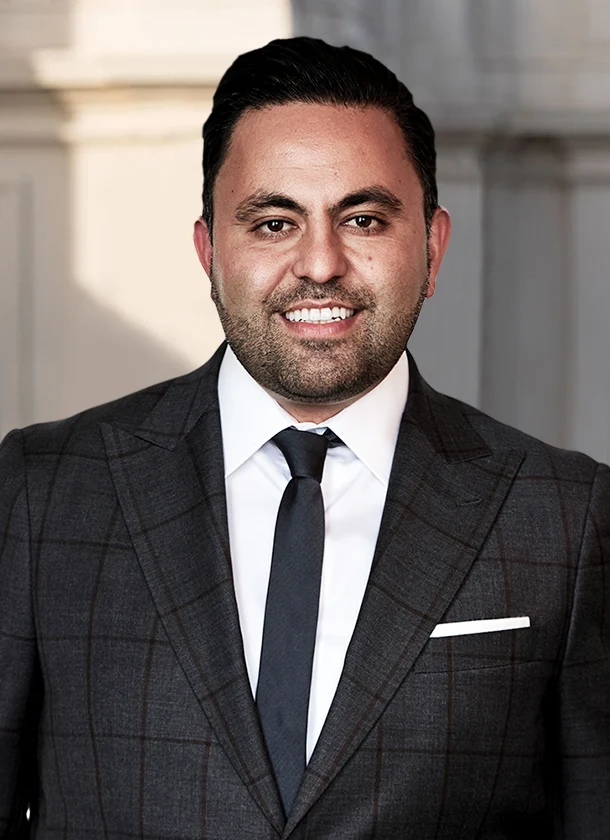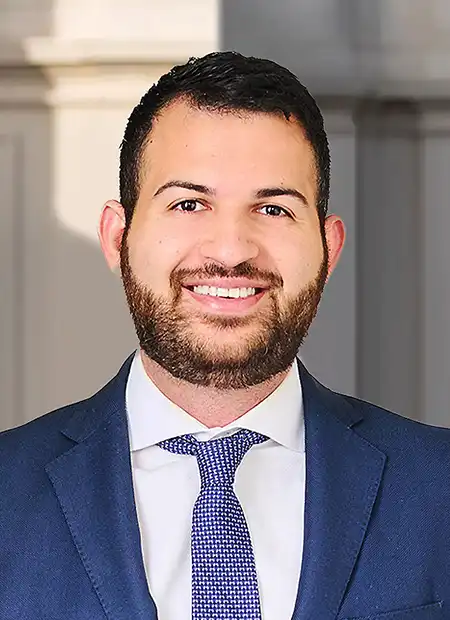Table of Contents
Is there a brain injury awareness month? Yes, March marks Brain Injury Awareness Month, when healthcare professionals, legal advocates, and support organizations unite to spotlight the critical issues brain injury survivors face. This nationwide initiative educates the public about the profound impact of brain injuries while emphasizing the vital importance of prevention, effective treatment options, and recovery resources for those affected.
With over 5.3 million Americans living with disabilities caused by traumatic brain injuries and approximately 800,000 new acquired brain injury cases occurring each year, awareness and education are essential. These injuries range from mild concussions to severe trauma, often resulting in significant physical, cognitive, and emotional challenges that can last a lifetime.
Understanding what to expect during recovery and knowing your legal rights can make a crucial difference in the quality of life and financial security for survivors and their families. This comprehensive guide covers everything you need to know about Brain Injury Awareness Month, the recovery process, and your legal options if you or a loved one has suffered a brain injury.
Understanding Brain Injury Awareness Month
Each year, Brain Injury Awareness Month focuses on a theme highlighting different aspects of brain injuries. For 2025, the theme “My Brain Injury Journey” emphasizes giving a voice and support to people who have experienced an acquired brain injury (ABI) or traumatic brain injury (TBI). The month-long observance aims to:
- Enhance public awareness of brain injuries and their lasting impacts on individuals and their families.
- Support survivors and their caregivers by connecting them with essential resources.
- Advocate for improved services and support systems for those affected by brain injuries.
- Encourage prevention through educational campaigns and safety initiatives.
Throughout March, organizations like the Brain Injury Association of America (BIAA) coordinate events, webinars, and social media campaigns to spread awareness and provide support. These initiatives help reduce stigma and create more inclusive communities for brain injury survivors.
Leading Causes Of Traumatic And Acquired Brain Injuries In The U.S.
Brain injuries can happen in an instant, forever changing the trajectory of a person’s life. According to the Centers for Disease Control and Prevention (CDC), approximately 69,000 people in the United States lost their lives due to TBI-related causes in 2021. Beyond these fatalities, millions more survive with varying degrees of disability and face challenging recovery journeys.
Brain injuries generally fall into two categories:
- Traumatic Brain Injuries — Caused by external forces that damage the brain. Recent CDC data shows several leading causes:
- Falls account for nearly half (48%) of all TBI-related hospitalizations, affecting older adults and young children most frequently.
- Firearm-related incidents, particularly suicides, represent the most common cause of TBI-related deaths in the United States.
- Motor vehicle crashes remain a leading cause of TBI-related hospitalizations, especially among teens and young adults.
- Physical assaults contribute significantly to TBIs, with victims often requiring specialized trauma care.
- Acquired Brain Injuries — Result from internal factors rather than external trauma. Common causes include:
- Strokes and cerebrovascular accidents.
- Oxygen deprivation.
- Infections affecting the brain (encephalitis, meningitis).
- Tumors and cancer treatments.
- Toxic exposure to chemicals or substances.
Understanding these risk factors enables individuals and communities to take preventive measures to mitigate them. Simple actions, such as wearing helmets during recreational activities, consistently using seatbelts, installing safety features in homes to prevent falls, and seeking prompt medical attention for neurological symptoms, can significantly reduce the risk of brain injury.
Understanding Brain Injury Awareness Symbols And Key Dates
Raising awareness about brain injuries is crucial for enhancing prevention, treatment, and support for individuals who have survived them. Recognizing key dates and symbols associated with Brain Injury Awareness Month helps bring attention to the challenges faced by those living with traumatic and acquired brain injuries.
What Is The Color For Brain Injury Awareness?
The green ribbon has become the internationally recognized symbol for traumatic brain injury awareness. This association began when a generous donor provided thousands of green wristbands for advocacy campaigns. The color green symbolizes growth, renewal, and hope — reflecting the recovery journey of brain injury survivors.
While green specifically represents TBI awareness, blue ribbons symbolize all types of brain injuries, including acquired brain injuries. The Brain Injury Association of America endorses both color initiatives to raise awareness and promote education about brain injuries.
During Brain Injury Awareness Month in March, you’ll see these green and blue ribbons displayed at community events, on social media campaigns, and throughout educational materials designed to inform the public about brain injuries and their lasting effects.
When Is Brain Injury Awareness Day?
Unlike some health causes with a single designated awareness day, brain injury awareness is observed throughout the month of March in the United States. This extended observance provides ample opportunity to highlight the complex challenges faced by brain injury survivors and emphasize the importance of prevention, treatment advances, and recovery support systems.
Throughout March, advocacy organizations, medical professionals, survivors, and caregivers collaborate on the following:
- Educational webinars and workshops.
- Community fundraising events.
- Social media awareness campaigns.
- Policy advocacy initiatives.
- Support group activities and resource sharing.
When Is Brain Health Month?
While March focuses on brain injury awareness, June is called Brain Health Month. This broader initiative addresses overall neurological wellness, including injury prevention, cognitive health maintenance, and brain-protective lifestyle choices.
During Brain Health Month, health experts emphasize:
- Nutrition and lifestyle choices that support brain health.
- Mental wellness strategies and stress management techniques.
- Cognitive training and brain exercises.
- Preventative measures to reduce risks of stroke, dementia, and TBIs.
- Latest research on neuroplasticity and brain function.
Together, these observances — Brain Injury Awareness Month in March and Brain Health Month in June — create a comprehensive approach to educating the public about brain protection, injury prevention, and recovery resources.
Brain Injury Recovery Process And Timeline
Recovering from a brain injury — whether a traumatic brain injury or a non-traumatic acquired brain injury — follows a highly individualized path. Recovery timelines vary significantly based on factors such as:
- The severity and location of the injury.
- How quickly treatment was initiated.
- The patient’s age and overall health.
- Access to specialized rehabilitation services.
- Pre-existing medical conditions.
- The strength of the patient’s support system.
While some individuals with mild injuries may recover completely within weeks or months, those with moderate to severe brain injuries often face a recovery journey measured in years, with some effects potentially lasting a lifetime.
Brain Injury Recovery Phases
Brain injury recovery is a gradual process that unfolds in distinct phases, each with its unique challenges and milestones. While every individual heals at their own pace, understanding the typical recovery timeline can help set expectations and guide treatment decisions. From the critical acute phase to long-term rehabilitation, each stage plays a vital role in maximizing recovery and improving quality of life.
- Acute Phase (Days to Weeks) — The initial recovery phase focuses on medical stabilization and preventing further complications. During this period, healthcare providers monitor brain pressure, manage inflammation, and address any life-threatening conditions.
- Subacute Phase (Weeks to Months) — Once medically stable, patients often transition to intensive rehabilitation. The most rapid improvements typically occur during the first six months after injury, though recovery continues beyond this window.
- Long-term Recovery (Months to Years) — While the recovery curve generally plateaus after 12-24 months, research shows that improvements can continue for years with appropriate therapy and support. The brain’s neuroplasticity (its ability to form new connections) means that progress remains possible long after the initial injury.
Key Steps In Brain Injury Recovery
Recovering from a brain injury is a complex process that looks different for everyone. While every case is unique, there are key steps that can help support healing and improve outcomes. These recommendations can guide you through recovery, but it’s essential to work closely with medical professionals and consider your legal options — especially if someone else’s negligence caused your injury.
Medical Treatment
Immediate medical intervention is crucial following any brain injury, whether from external trauma (TBI) like a car accident or fall, or from internal causes (ABI) such as a stroke or tumor. Healthcare providers use comprehensive neurological examinations, MRI scans, and CT imaging to assess the extent of damage and determine optimal treatment protocols. Prompt medical care significantly improves recovery outcomes by limiting secondary damage and preventing complications.
Rehabilitation
Most brain injury survivors require specialized rehabilitation programs to regain lost functions and develop compensatory strategies. Comprehensive rehabilitation typically includes:
- Physical therapy to restore movement, balance, coordination, and strength.
- Occupational therapy to relearn daily living skills and develop strategies for independence.
- Speech-language therapy to address communication difficulties, swallowing issues, and cognitive challenges.
- Cognitive rehabilitation to improve memory, attention, problem-solving, and executive functioning.
- Vocational rehabilitation to facilitate return to work or school with appropriate accommodations.
Emotional And Mental Health Support
Brain injuries frequently affect emotional regulation and mental health, with survivors commonly experiencing depression, anxiety, personality changes, and post-traumatic stress disorder (PTSD). Comprehensive recovery plans should include the following:
- Psychological counseling with therapists specializing in neurological conditions.
- Psychiatric care for medication management when appropriate.
- Support groups that help connect survivors with peers who understand their challenges.
- Family therapy to help loved ones adjust to changes and develop effective support strategies.
Lifestyle Adjustments
Many survivors must adapt to new physical, cognitive, or emotional limitations that affect their daily lives. Successful long-term adaptation often involves:
- Home modifications to accommodate physical limitations.
- Assistive technologies to support independence.
- Structured daily routines to compensate for cognitive challenges.
- Development of new skills and interests that accommodate changed abilities.
- Regular follow-up care with specialized healthcare providers.
While every brain injury recovery journey is unique, early intervention, comprehensive rehabilitation, consistent emotional support, and appropriate accommodations significantly improve the quality of life outcomes for survivors.
Understanding Your Legal Rights After A Brain Injury
Traumatic brain injuries (TBIs) are a major public health concern, affecting 18.2% of the U.S. population. When a brain injury results from another party’s negligence or wrongful actions, survivors may have the right to pursue compensation for the devastating impact on their lives. Brain injuries can lead to astronomical medical expenses, substantial lost income, and significant life changes requiring long-term care, making financial recovery essential for survivors and their families.
Types Of Legal Claims For Brain Injury Compensation
Suffering a brain injury can have life-altering consequences, from mounting medical bills to long-term rehabilitation and lost income. If your injury was due to someone else’s negligence, you may be entitled to compensation under the law. However, the type of legal claim you pursue will depend on the specific circumstances of your case.
Different situations require different legal approaches, whether the injury resulted from a traffic accident, a workplace incident, medical malpractice, or a hazardous property condition. Understanding the types of claims available can help you take the necessary steps to secure the compensation you deserve under the law.
Personal Injury Claims
Brain injuries can happen in many ways, but when they result from someone else’s negligence, you may have grounds for a personal injury claim. Whether it’s a reckless driver, a hazardous property, or an unsafe work environment, victims have legal options to seek compensation. Below are common scenarios in which brain injuries occur, along with the legal claims that may be applicable to them.
- Auto Accidents — When drivers violate traffic laws or drive distracted, causing crashes that result in brain injuries.
- Slip And Fall Incidents — Property owners failing to maintain safe premises, leading to slip-and-falls and head injuries.
- Sports Injuries — Improper supervision, inadequate safety equipment, or negligent coaching can cause preventable brain injuries.
- Workplace Accidents — Unsafe working conditions or OSHA violations resulting in head trauma.
Medical Malpractice Claims
Medical professionals must provide safe and competent care, but when they make critical mistakes, the consequences can be devastating. Brain injuries caused by medical negligence can lead to lifelong complications, affecting both patients and their families. The following are common types of medical malpractice that can result in brain damage and may warrant a legal claim:
- Surgical errors leading to oxygen deprivation.
- Misdiagnosis or delayed diagnosis of stroke, aneurysm, or brain infection.
- Birth injuries that result in infant brain damage.
- Medication errors that affect brain function.
Product Liability Claims
Product failures or malfunctions can be catastrophic — especially when brain injuries are involved. Manufacturers have a responsibility to ensure their products are safe, but defects or design flaws can put users at serious risk. Below are common product failures that can lead to brain injuries and may justify a product liability claim:
- Defective safety equipment that fails to prevent head trauma.
- Vehicle design flaws that contribute to crash injuries.
- Dangerous recreational equipment that can cause preventable brain injuries.
Key Legal Considerations For Brain Injury Claims
Pursuing a brain injury claim involves more than proving the injury itself. It requires understanding the legal factors that can impact your case. From liability and evidence to deadlines and compensation, several key considerations can influence the outcome of your claim. Here are some important legal aspects to keep in mind when seeking justice for a brain injury.
Proving Liability For Brain Injuries
Successful brain injury claims require establishing four essential elements:
- Duty of Care — Demonstrating that the defendant had a legal obligation to act reasonably (e.g., drivers must follow traffic laws, doctors must provide competent care).
- Breach of Duty — Showing that the responsible party failed to meet their obligation through negligent actions or omissions.
- Causation — Establishing a direct link between the breach of duty and the resulting brain injury.
- Damages — Documenting the physical, emotional, and financial consequences of the injury.
Strong evidence is the foundation of a successful brain injury claim, helping to prove negligence, establish the extent of harm, and demonstrate the financial impact of the injury. Evidence crucial for brain injury cases typically includes:
- Medical records documenting the injury and treatment plan.
- Expert testimony from neurologists and rehabilitation specialists.
- Accident reports and incident documentation.
- Witness statements describing the event.
- Visual evidence, such as security footage or accident scene photos.
- Economic analysis of long-term costs and financial impact.
Types Of Compensation For Brain Injury Cases
Victims of brain injuries often face significant challenges that can impact various aspects of their lives. As a result, they may be able to receive compensation that covers all their losses, which can include:
- Economic Damages — These damages refer to the quantifiable financial losses incurred by an individual or entity due to an injury or wrongful act. These include:
- Current and future medical expenses, including hospital bills, rehabilitation costs, and ongoing therapies.
- Lost wages from missed work during recovery.
- Reduced earning capacity if the injury prevents returning to previous employment.
- Home modifications such as wheelchair ramps, bathroom adaptations, or special equipment.
- Costs for in-home care, specialized transportation, or adaptive technologies.
- Non-Economic Damages — These damages refer to compensation awarded to an individual for losses that do not have a specific monetary value, including the following:
- Physical pain and suffering endured.
- Emotional distress and psychological trauma.
- Loss of enjoyment of life and inability to participate in former activities.
- Changes in personal relationships and consortium claims.
- Punitive Damages — This is additional compensation awarded in rare cases involving gross negligence or intentional misconduct. They aim to punish the at-fault party for reckless behavior and to deter similar future conduct.
Statute Of Limitations
Every state imposes strict time limits for filing brain injury lawsuits. In California, for example, victims typically have:
- Two years from the date of injury for personal injury claims.
- Three years from the date of injury for property damage claims.
- One year after the discovery of medical malpractice claims.
Missing these critical deadlines can permanently bar recovery, making prompt legal consultation essential after any brain injury.
An experienced brain injury attorney provides invaluable assistance by:
- Conducting thorough investigations to identify all liable parties.
- Consulting with medical experts to establish the full extent of injuries.
- Calculating accurate current and future damages.
- Negotiating effectively with insurance companies.
- Preparing compelling cases for trial when insurance companies refuse to offer fair settlements.
If you or a loved one has suffered a brain injury due to another’s negligence, consulting with a qualified brain injury lawyer at Arash Law can protect your rights and maximize your recovery.
Protecting Your Rights After A Brain Injury
Brain Injury Awareness Month serves as a powerful reminder that brain injuries can transform lives in an instant. However, awareness, prevention, proper medical care, and appropriate legal action can profoundly affect survivors’ recovery outcomes and quality of life.
Taking Action After A Brain Injury
If you or someone you love sustained a brain injury, consider these recommended steps:
- Prioritize Medical Care — Seek immediate treatment and follow all medical recommendations, keeping detailed records of all appointments, treatments, and medications.
- Document Everything — Maintain a comprehensive journal of symptoms, challenges, and how the injury affects daily life. This documentation is invaluable for medical treatment and potential legal claims.
- Preserve Evidence — If the injury resulted from an accident, collect and preserve all relevant evidence, including photographs, witness information, incident reports, and any communication with involved parties.
- Connect with Support Resources — Organizations like the Brain Injury Association of America provide essential information, support groups, and resources for survivors and families navigating recovery.
- Understand Your Legal Options — When someone else’s negligence caused your brain injury, you shouldn’t bear the financial burden alone. A brain injury attorney can help you understand your rights and pursue appropriate compensation.
Benefits Of Legal Representation For Brain Injury Cases
The right legal representation can significantly impact your recovery journey by:
- Ensuring you receive fair compensation that accounts for both current and future needs.
- Handling complex legal procedures while you focus on recovery.
- Connecting you with medical experts who can properly document your injuries and future needs.
- Advocating fiercely on your behalf against insurance companies that often minimize brain injury claims.
- Providing peace of mind and protecting your legal rights throughout the process.
The Importance Of Personalized Brain Injury Representation
Not all personal injury attorneys have experience with the complex nature of brain injury cases. Brain injuries present unique challenges due to the following reasons:
- Symptoms may evolve, with some effects appearing weeks or months after the initial injury.
- The full impact on cognitive function, emotional regulation, and quality of life can be difficult to quantify.
- Insurance companies frequently undervalue “invisible injuries” that don’t show on standard imaging.
- The long-term costs of care and rehabilitation can often add up to millions of dollars over a lifetime.
Arash Law’s experienced brain injury attorneys and car accident lawyers understand these complexities and have successfully helped numerous victims secure the compensation they legally deserve.
For example, one of the partners at our injury law firm, Tina Eshghieh, Esq., has successfully recovered over $50 million for clients with brain injuries. Known as #TBITina, she has built a reputation for consistently winning brain injury cases, fighting fiercely and relentlessly for justice.
Whether your injury resulted from a car accident, workplace incident, medical malpractice, or another act of negligence, our team has the experience to build a compelling case that fully addresses your long-term needs.
Why Immediate Legal Action Is Critical In Brain Injury Claims
With strict statutes of limitations governing brain injury claims, prompt legal consultation is essential. Delaying action may jeopardize your right to compensation and limit access to resources needed for optimal recovery.
Remember that brain injury recovery is a marathon, not a sprint. Having the right medical team, support network, and legal representation can make all the difference in your journey toward achieving potential recovery and maintaining a high quality of life.
This Brain Injury Awareness Month, take proactive steps to protect yourself and your loved ones. Learn about prevention strategies, recognize early warning signs of brain injuries, and know your rights if an injury occurs. By building awareness and taking action together, we can improve outcomes for brain injury survivors nationwide.
For a free, confidential consultation about your brain injury case, call Arash Law at (888) 488-1391 today. Our compassionate team is ready to answer your questions and help you understand your options for recovery and compensation.

